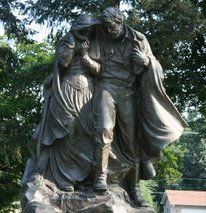Death in 19th-century Mormonism
Death in 19th-century Mormonism
Death in 19th-century Mormonism was a significant aspect of the Latter Day Saint movement and had profound implications on the religious and cultural practices of the Church of Jesus Christ of Latter-day Saints (LDS Church) and other Mormon denominations. The 19th century was a period of intense growth, migration, and conflict for the Mormon community, and death played a central role in shaping their beliefs and practices.
Beliefs about Death[edit | edit source]
Mormons in the 19th century held distinct beliefs about death and the afterlife, influenced by the teachings of Joseph Smith, the founder of the LDS Church. According to Mormon doctrine, death was seen as a transition to the spirit world, where the deceased would await the resurrection and final judgment. The spirit world was divided into paradise and spirit prison, where spirits would either rest or continue to learn and repent.
Funerary Practices[edit | edit source]
Funerary practices among 19th-century Mormons were deeply rooted in their religious beliefs. Funerals were often held in meetinghouses or homes, and they included prayers, hymns, and sermons that emphasized the hope of resurrection and eternal life. The deceased were typically buried in simple graves, often in family or community cemeteries.
Martyrdom and Persecution[edit | edit source]
The 19th century was marked by significant persecution and violence against Mormons, leading to the deaths of many members. The most notable instance was the martyrdom of Joseph Smith and his brother Hyrum Smith in 1844. Their deaths had a profound impact on the Mormon community, solidifying their resolve and faith. The Nauvoo Expositor incident and the subsequent Carthage Jail attack are key events related to this period.
Migration and Hardship[edit | edit source]
The Mormon pioneers' migration to the Salt Lake Valley in the mid-19th century was fraught with hardship and death. Many pioneers succumbed to disease, harsh weather, and lack of resources during the Mormon Trail journey. The Willie and Martin handcart companies are notable examples of the extreme challenges faced by these early settlers.
Theological Developments[edit | edit source]
The 19th century also saw significant theological developments regarding death and the afterlife within Mormonism. The introduction of baptism for the dead and other temple ordinances reflected the evolving understanding of the afterlife and the importance of performing saving ordinances for deceased ancestors.
Impact on Community and Culture[edit | edit source]
Death in 19th-century Mormonism had a profound impact on the community and culture. It reinforced the importance of family, community support, and religious faith. The shared experiences of loss and hardship helped to strengthen the bonds among members and foster a sense of unity and purpose.
See Also[edit | edit source]
- Latter Day Saint movement
- Joseph Smith
- Mormon pioneers
- Mormon Trail
- Baptism for the dead
- Temple ordinances
References[edit | edit source]
Search WikiMD
Ad.Tired of being Overweight? Try W8MD's physician weight loss program.
Semaglutide (Ozempic / Wegovy and Tirzepatide (Mounjaro / Zepbound) available.
Advertise on WikiMD
|
WikiMD's Wellness Encyclopedia |
| Let Food Be Thy Medicine Medicine Thy Food - Hippocrates |
Translate this page: - East Asian
中文,
日本,
한국어,
South Asian
हिन्दी,
தமிழ்,
తెలుగు,
Urdu,
ಕನ್ನಡ,
Southeast Asian
Indonesian,
Vietnamese,
Thai,
မြန်မာဘာသာ,
বাংলা
European
español,
Deutsch,
français,
Greek,
português do Brasil,
polski,
română,
русский,
Nederlands,
norsk,
svenska,
suomi,
Italian
Middle Eastern & African
عربى,
Turkish,
Persian,
Hebrew,
Afrikaans,
isiZulu,
Kiswahili,
Other
Bulgarian,
Hungarian,
Czech,
Swedish,
മലയാളം,
मराठी,
ਪੰਜਾਬੀ,
ગુજરાતી,
Portuguese,
Ukrainian
Medical Disclaimer: WikiMD is not a substitute for professional medical advice. The information on WikiMD is provided as an information resource only, may be incorrect, outdated or misleading, and is not to be used or relied on for any diagnostic or treatment purposes. Please consult your health care provider before making any healthcare decisions or for guidance about a specific medical condition. WikiMD expressly disclaims responsibility, and shall have no liability, for any damages, loss, injury, or liability whatsoever suffered as a result of your reliance on the information contained in this site. By visiting this site you agree to the foregoing terms and conditions, which may from time to time be changed or supplemented by WikiMD. If you do not agree to the foregoing terms and conditions, you should not enter or use this site. See full disclaimer.
Credits:Most images are courtesy of Wikimedia commons, and templates Wikipedia, licensed under CC BY SA or similar.
Contributors: Prab R. Tumpati, MD






